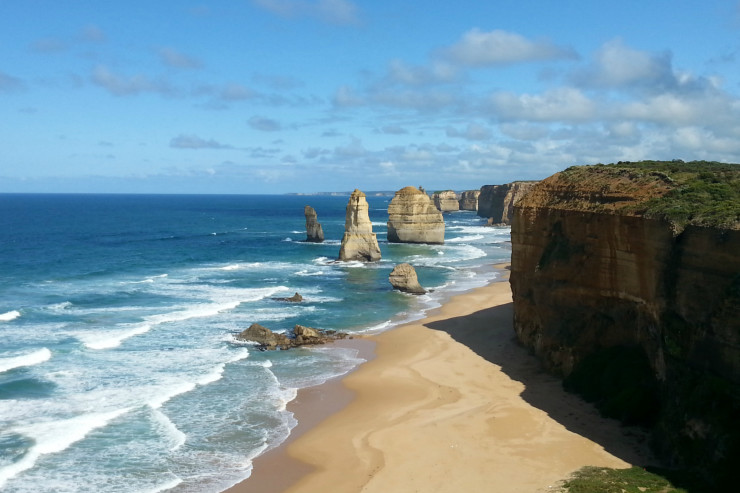Best time to walk the Great Ocean Walk

Best time to walk the Great Ocean Walk
Posted on
Best time to walk the Great Ocean Walk Main Points
- The Great Ocean Walk offers year-round beauty with rugged coastlines, shipwrecks, and wildlife, ideal for photographers.
- The best time to walk is subjective, influenced by Victoria’s variable weather and personal preferences.
- Summer: Ideal for swimming with mid-20s temperatures, but be cautious of bushfires, snakes, and insects.
- Autumn: Stable weather with crisp mornings and long sunny days, fewer insects and snakes, and spectacular sunsets.
- Winter: High rainfall and potential for muddy tracks, but offers solitude, dramatic winter swells, and wildlife spotting.
- Spring: Variable weather with vibrant wildflowers, but also brings snakes and insects.
The Great Ocean Walk is beautiful all year round. No matter when you visit, you’ll experience one of the most beautiful and rugged coastlines Australia has to offer. It’s a photographer’s dream, with deserted beaches, coastal heath, shipwreck sites, wildlife, and those famous limestone stacks.
The best time to walk the Great Ocean Walk is therefore pretty subjective. Aside from the fact that the state of Victoria is famous for putting on “four seasons in one day”, there’s also the fact that everyone’s looking for something different. Yes, believe it or not, some people actually don’t mind cold and wet weather when they’re on the trail.
So, I guess the best I can do is give you the pros and cons of visiting in each season. There’s only one thing to keep in mind no matter which season you choose, make sure you check the Victorian school holiday dates first. School holiday periods will mean more people on the trail, especially in the summer holidays, and of course you’ll need to book further in advance.
Summer
December to February is my favourite time to visit this beautiful coastline because it provides the highest chance for swimming weather. You might be put off hiking the Great Ocean Walk in summer because of the potential for scorching hot days, but the reality is that average temperatures are more likely to be in the mid-20s. February tends to have the highest number of days above 30 degrees and also the lowest number of cloudy or rainy days. Carrying sufficient water is particularly essential in summer as heat exhaustion is a very real threat. On the upside, you’ll always have the ocean within stone’s throw to help cool yourself down.
Bushfires do happen in the Otway National Park and can be devastating. You should check in with the Country Fire Authority before your walk for any fires, warnings and restrictions. You should consider cancelling your trip if there are days of high fire danger, and you should familiarise yourself with escape routes in case the worst happens.
Summer brings more flies and mosquitos, which do take some getting used to, and also snakes. In my years of walking in the Australian bush, I’ve encountered hundreds of snakes. I’ve even come ridiculously close to stepping on them, but I’ve never been bitten. They should be treated with respect but I don’t think they’re a reason not to walk. Keep your eyes peeled on the trail and when you see one, stay well clear of it. They will usually get out of your way without any prompting. Most snake bites occur when someone tries to kill them, so just leave them alone.

Autumn
Many hikers say autumn is the best time to walk the Great Ocean Walk, especially March and April. Autumn has the most stable weather with crisp mornings and long, sunny, and occasionally even hot days. It’s the perfect walking weather.
Flies, mosquitoes, snakes, and bushfires are still potential downsides, especially in March, but they are much less of an issue than they are in summer.
Autumn is also known for bringing with it some spectacular sunsets, so photographers should have their camera at the ready.
Winter
The Otway’s and Great Ocean Road region is generally well known for having the highest rainfall in Victoria, so you can forget about hiking the Great Ocean Walk in the winter months if you’re hoping to stay dry. Muddy and slippery tracks may also be an issue but hikers who don’t mind all of this may find that they get the trail all to themselves. If it’s that isolation that you seek, this may be the perfect time of year for you.
Aside from the lonely trails, winter highlights include beach walk sections set off by giant winter swells, those intense sunsets, hillsides covered in pink heath, and even the potential to spot migrating Southern right whales.
Winter hikers should come prepared with the right gear for cold and wet conditions. You’ll also need to take ocean surges into account for the walk’s beach sections.
Guided hiking tours are uncommon in winter because there isn’t as much demand, but experienced hikers can still take on the trail. Transfer services do still operate on demand throughout winter.

Spring
The most variable weather on the Great Ocean Walk is in Spring, with perfect sunny days generally just as common as wet and windy days. Average temperatures are in the mid-20s, though. Warmer weather brings out the snakes and other creepie crawlies, so make sure you bring plenty of repellent.
The obvious attraction of taking on the Great Ocean Walk from September to November are the wildflowers. Spring is the most colourful time of year in the Australian bush. Walkers this time of year see the landscape slashed with vibrant patches of intense colour, which makes for amazing landscape photography.
There’s no doubt this is one of the best coastal hikes in the world. So the best time to walk the Great Ocean Walk is whenever you decide to visit.
If you are interested in walking the Great Ocean walk, please check out our guided tours.
-Neil Fahey
Guest Blogger



